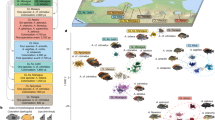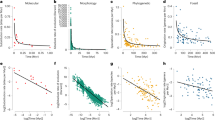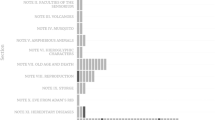Key Points
-
Studies of reproductive isolation have shown that the number of genes that are involved is often large. Between closely related species of Drosophila, the number of such genes might often be in the hundreds.
-
Speciation genes — that is, the genes that underlie reproductive isolation — can contribute to hybrid inviability, sterility or behavioural aberration, as well as ecological maladaptation.
-
In the genic view of speciation, loci that are not closely linked to speciation genes might continue to be shared between nascent species, as in parapatric speciation.
-
At least five cases of speciation genes have been confirmed so far. Most bear a strong signature of positive selection. Three of the five known speciation genes are related to transcriptional regulation, supporting the postulate that species divergence is often regulatory in nature.
-
For a gene to diverge in function, it needs to be released from the old functional niche (genetic 'niche-release'). So, speciation genes are often non-essential, with functions that are only loosely coupled to reproductive isolation. In a few cases, gene knock-out studies — the ultimate way to test the dispensability of a gene — have been able to show the non-essential nature of specific speciation genes.
-
Genomic data might help to resolve the long-running debate on the relative importance of allopatric and parapatric modes of speciation. Models of allopatric speciation make specific testable predictions about the level of divergence across the whole genome.
Abstract
It is only in the past five years that studies of speciation have truly entered the molecular era. Recent molecular analyses of a handful of genes that are involved in maintaining reproductive isolation between species (speciation genes) have provided some striking insights. In particular, it seems that despite being strongly influenced by positive selection, speciation genes are often non-essential, having functions that are only loosely coupled to reproductive isolation. Molecular studies might also resolve the long-running debate on the relative importance of allopatric and parapatric modes of speciation.
This is a preview of subscription content, access via your institution
Access options
Subscribe to this journal
Receive 12 print issues and online access
$189.00 per year
only $15.75 per issue
Buy this article
- Purchase on Springer Link
- Instant access to full article PDF
Prices may be subject to local taxes which are calculated during checkout



Similar content being viewed by others
References
Dobzhansky, T. Genetics of the Evolutionary Process (Columbia Univ. Press, New York, 1970).
Fisher, R. A. The Genetical Theory of Natural Selection (Clarendon, Oxford, 1930).
Mayr, E. Animal Species and Evolution (The Belknap, Cambridge, Massachusetts, 1963).
Wilson, A. C., Maxon, L. R. & Sarich, V. M. Two types of molecular evolution. Evidence from studies of interspecific hybridization. Proc. Natl Acad. Sci. USA 71, 2843–2847 (1974).
Wu, C. -I. The genic view of the process of speciation. J. Evol. Biol. 14, 851–865 (2001). In this genic view of speciation, RI develops gradually across the genome with some genes being unable to permeate through the nascent species boundary early on, whereas other genes continue to flow between them until complete RI evolves. The view suggests that parapatry is a common mode of speciation.
Mayr, E. Integration of genotypes: synthesis. Cold Spring Harb. Symp. Quant. Biol. 20, 327–333 (1955).
Wu, C. -I. Gene and speciation. J. Evol. Biol. 14, 889–891 (2001).
Howard, D. J. & Berlocher, S. H. Endless Forms (Oxford Univ. Press, New York, 1998).
Wu, C. -I. & Hollocher, H. in Endless Forms: Species and Speciation. (ed. Berlocher, S.) 339–351 (Oxford Univ. Press, Oxford, 1998).
Wu, C. -I. & Palopoli, M. F. Genetics of postmating reproductive isolation in animals. Ann. Rev. Genet. 28, 283–308 (1994).
Coyne, J. A. & Orr, H. A. The evolutionary genetics of speciation. Philos. Trans. R. Soc. Lond. B 28, 287–305 (1998).
Zeng, Z. -B. et al. Genetic architecture of a morphological shape difference between two Drosophila species. Genetics 154, 299–310 (2000).
Ting, C. -T., Takahashi, A. & Wu, C. -I. Incipient speciation by sexual isolation in Drosophila: concurrent evolution at multiple loci. Proc. Natl Acad. Sci. USA 98, 6709–6713 (2001).
Takahashi, A. & Ting, C. -T. Genetic basis of sexual isolation in Drosophila melanogaster. Genetia (in the press).
Doi, M., Matsuda, M., Tomaru, M., Matsubayashi, H. & Oguma, Y. A locus for female mate discrimination causing sexual isolation in Drosophila. Proc. Natl Acad. Sci. USA 98, 6714–6719 (2001).
Tao, Y., Zeng, Z. -B., Li, J., Hartle, D. L. & Laurie, C. C. Genetic dissection of hybrid incompatabilities between Drosophila simulans and D. mauritiana. II. Mapping hybrid sterility loci on the third chromosome. Genetics 164, 1399–1418 (2003).
Wu, C. -I. & Davis, A. W. Evolution of postmating reproductive isolation: the composite nature of Haldane's rule and its genetic bases. Am. Nat. 142, 187–212 (1993).
Wu, C. -I., Johnson, N. A. & Palopoli, M. F. Haldane's rule and its legacy: why are there so many sterile males? Trends Ecol. Evol. 11, 281–284 (1996).
Presgraves, D. C. A fine-scale genetic analysis of hybrid incompatibilities in Drosophila. Genetics 163, 955–972 (2003).
Sawamura, K., Davis, A. W. & Wu, C. -I. Genetic analysis of speciation by means of introgression into Drosophila melanogaster. Proc. Natl Acad. Sci. USA 97, 2652–2655 (2000).
Sawamura, K., Roote, J., Wu, C. -I. & Yamamoto, M. Reassessment of the two-locus Dobzhansky-Muller model of reproductive isolation: extreme genetic complexity underlying hybrid male sterility in Drosophila. Genetics (in the press).
Presgraves, D. C., Balagopalan, L., Abmayr, S. M. & Orr, H. A. Adaptive evolution drives divergence of a hybrid inviability gene between two species of Drosophila. Nature 423, 715–719 (2003). One of the five 'speciation genes' that has been characterized so far is presented in this study. The influence of positive selection on its divergence between species is clearly shown (see main text for detail).
Rawson, P. D. & Burton, R. S. Functional coadaptation between cytochrome c and cytochrome c oxidase within allopatric populations of a marine copepod. Proc. Natl Acad. Sci. USA 99, 12955–12858 (2002).
Cordon, M. The genetics of a viviparous top-minnow Platpoecilus: the inheritance of two kinds of melanophores. Genetics 12, 253–2283 (1927).
Kosswig, C. Uber bastarde der teleostier Platypoecilus und Xiphophorus. Zeitschrift fur induktive Abstammungs und Vererbungslehre 44, 253 (1927).
Anders, F. Contributions of the Gordon-Kosswig melanoma system to the present concept of neoplasia. Pigment Cell Res. 4, 7–29 (1991).
Schartl, M. A sex chromosomal restriction-fragment-length marker linked to melanoma-determining Tu loci in Xiphophorus. Genetics 119, 679–685 (1988).
Wittbrodt, J. et al. Novel putative receptor tyrosine kinase encoded by the melanoma-inducing Tu locus in Xiphophorus. Nature 341, 415–421 (1989). Tu is perhaps one of the first genes that was identified to be incompatible between closely related species. The mechanism of fitness reduction in the hybrids is shown to be tumorigenesis (see main text for detail).
Zechel, C., Schleenbecker, U., Anders, A. & Anders, F. v-erbB related sequences in Xiphophorus that map to melanoma determining Mendelian loci and overexpress in a melanoma cell line. Oncogene 3, 605–617 (1988).
Wittbrodt, J., Lammers, R., Malitschek, B., Ullrich, A. & Schartl, M. The Xmrk receptor tyrosine kinase is activated in Xiphophorus malignant melanoma. EMBO J. 11, 4239–4246 (1992).
Adam, D., Dimitrijevic, N. & Schartl, M. Tumor suppression in Xiphophorus by an accidentally acquired promoter. Science 259, 816–819 (1995).
Gomez, A., Wellbrock, C., Gutbrod, H., Dimitrijevic, N. & Schartl, M. Ligand-independent dimerization and activation of the oncogenic Xmrk receptor by two mutations in the extracellular domain. J. Biol. Chem. 276, 3333–3340 (2001).
Wellbrock, C. et al. Signalling by the oncogenic receptor tyrosine kinase Xmrk leads to activation of STAT5 in Xiphophorus melanoma. Oncogene 16, 3047–3056 (1998).
Ting, C. -T., Tsaur, S. C., Wu, M. -L. & Wu, C. -I. A rapidly evolving homeobox at the site of a hybrid sterility gene. Science 282, 1501–1504 (1998). This study reported the cloning of the OdsH gene of hybrid male sterility. OdsH is an example of a homeobox gene, a family of genes that are generally highly conservative and are therefore unlikely candidates for speciation genes.
Sun, S. Functional Analysis of the Hybrid Male Sterility Gene Odysseus in Drosophila. (Univ. Chicago Press, Chicago, 2003).
Ashburner, M. Drosophila: A Laboratory Handbook (Cold Spring Harbor Laboratory Press, New York, 1989).
Sawamura, K., Yamamoto, M. -T. & Watanabe, T. K. Hybrid lethal systems in the Drosophila melanogaster species complex. II. The zygotic hybrid rescue (zhr) gene of Drosophila simulans. Genetics 133, 307–313 (1993).
Hutter, P. Genetics of hybrid inviability in Drosophila. Adv. Genet. 36, 157–185 (1997).
Watanabe, T. K. A gene that rescues the lethal hybrids between Drosophila melanogaster and Drosophila simulans. Jpn. J. Genet. 54, 325–331 (1979).
Hutter, P. & Ashburner, M. Genetic rescue of inviable hybrids between Drosophila melanogaster and its sibling species. Nature 327, 331–333 (1987).
Hutter, P., Roote, J. & Ashburner, M. A genetic basis for the inviability of hybrids between sibling species of Drosophila. Genetics 124, 909–920 (1990).
Sawamura, K., Watanabe, T. K. & Yamamoto, M. -T. Hybrid lethal systems in the Drosophila melanogaster species complex. Genetica 88, 175–185 (1993). A detailed description of the various mutations in D. melanogaster that suppress hybird inviabilities.
Sawamura, K., Taira, T. & Watanabe, T. K. Hybrid lethal systems in the Drosophila melanogaster species complex. I. The maternal hybrid rescue (mhr) gene of Drosophila simulans. Genetics 133, 299–305 (1993).
Barbash, D. A., Siino, D. F., Tarone, A. M. & Roote, J. A rapidly evolving MYB-related protein causes species isolation in Drosophila. Proc. Natl Acad. Sci. USA 100, 5302–5307 (2003). Molecular cloning of one of the suppressor mutations of hybrid inviabilities (see main text for detail).
Barbash, D. A., Roote, J. & Ashburner, M. The Drosophila melanogaster hybrid male rescue gene causes inviability in male and female species hybrids. Genetics 154, 1747–1771 (2003).
Belgareh, N. et al. An evolutionarily conserved NPC subcomplex, which redistributes in part to kinetochores in mammalian cells. J. Cell Biol. 154, 1147–1160 (2001).
Ferveur, J. F., Cobb, M., Boukella, H. & Jallon, J. -M. World-wide variation in Drosophila melanogaster sex pheromone: behavioural effects, genetic bases and potential evolutionary consequences. Genetica 97, 73–80 (1996).
Dallerac, R. et al. A delta 9 desaturase gene with a different substrate specificity is responsible for the cuticular diene hydrocarbon polymorphism in Drosophila melanogaster. Proc. Natl Acad. Sci. USA 97, 9449–9454 (2000).
Takahashi, A., Tsaur, S. C., Coyne, J. A. & Wu, C. -I. The nucleotide changes governing cuticular hydrocarbon variation and their evolution in Drosophila melanogaster. Proc. Natl Acad. Sci. USA 98, 3920–3925 (2001).
Greenberg, A. J., Moran, J. R., Coyne, J. A. & Wu, C. -I. Ecological adaptation during incipient speciation revealed by precise gene replacement. Science 320, 1754–1757 (2003). The first application of gene replacement between nascent species shows the ecological consequence of desaturase divergence, cold tolerance, starvation intolerance and pheromonal changes. Mate choice might be affected by these pheromones.
Wu, C. -I. et al. Sexual isolation in Drosophila melanogaster: a possible case of incipient speciation. Proc. Natl Acad. Sci. USA 92, 2519–2523 (1995).
Coyne, J. A., Crittenden, A. P. & Mah, K. Genetics of a pheromonal difference contributing to reproductive isolation in Drosophila. Science 265, 1461–1464 (1994).
Fang, S., Takahashi, A. & Wu, C. -I. A mutation in the promoter of desaturase 2 is correlated with sexual isolation between Drosophila behavioral races. Genetics 162, 781–784 (2003).
Wood, D. & Ringo, J. M. Male mating discrimination in Drosophila melanogaster, D. simulans and their hybrids. Evolution 34, 320–329 (1980).
Watterson, G. A. On the number of segregating sites in genetical models without recombination. Theoret. Pop. Biol. 7, 256–276 (1975).
Li, W. H. Distribution of nucleotide differences between two randomly chosen cistrons in a finite population. Genetics 85, 331–337 (1977).
Gillespie, J. H. & Langley, C. H. Are evolutionary rates really variable? J. Mol. Evol. 13, 27–34 (1979).
Hudson, R. R. Properties of a neutral allele model with intragenic recombination. Theoret. Pop. Biol. 23, 183–201 (1983).
Takahata, N. Gene diversity in finite populations. Genet. Res. 46, 107–113 (1985).
Wakeley, J. & Hey, J. Estimating ancestral population parameter. Genetics 145, 847–855 (1997).
Wang, R. L., Wakeley, J. & Hey, J. Gene flow and natural selection in the origin of Drosophila pseudoobscura and close relatives. Genetics 147, 1091–1106 (1997).
Kliman, R. M. et al. The population genetics of the origin and divergence of the Drosophila simulans complex species. Genetics 156, 1913–1931 (2000).
Machado, C. A., Kliman, R. M., Markert, J. A. & Hey, J. Inferring the history of speciation from multilocus DNA sequence data: the case of Drosophila pseudoobscura and close relatives. Mol. Biol. Evol. 19, 472–488 (2002).
Li, W. H. Distribution of nucleotide differences between two randomly chosen cistrons in a finite population. Genetics 85, 331–337 (1977).
Takahata, N., Satta, Y. & Klein, J. Divergence time and population size in the lineage leading to modern humans. Theoret. Pop. Biol. 48, 198–221 (1995).
Takahata, N. & Satta, Y. Evolution of the primate lineage leading to modern humans: phylogenetic and demographic inference from DNA sequences. Proc. Natl Acad. Sci. USA 94, 4811–4815 (1997).
Wall, J. D. Estimating ancestral population sizes and divergence times. Genetics 163, 395–404 (2003).
Navarro, A. & Barton, N. H. Chromosomal speciation and molecular divergence-accelerated evolution in rearranged chromosomes. Science 300, 321–324. (2003).
Lu, J., Li, W. H. & Wu, C. -I. Comment on 'chromosomal speciation and molecular divergence-accelerated evolution in rearranged chromosomes'. Science 302, 988 (2003).
Navarro, A., Marquès-Bonet, T. & Barton, N. H. Response to comment on 'chromosomal speciation and molecular divergence-accelerated evolution in rearranged chromosomes'. Science 302, 988 (2003).
Rieseberg, L. H. et al. Major ecological transitions in wild sunflowers facilitated by hybridization. Science 301, 1211–1216 (2003). This study recreated new species in sunflowers by hybridization between two good species. The synthetic new species mimicked the naturally-occurring ancient hybridizations. Certain combinations of the parental genomes are favoured by natural selection. Hybridization speciation shows the 'modular' nature of the genome (see reference 5).
Lynch, M. & Conery, J. S. The evolutionary fate and consequences of duplicate genes. Science 290, 1151–1155 (2000).
Mayr, E. Wu's genic view of speciation. J. Evol. Biol. 14, 866–867 (2001).
Acknowledgements
We thank S. Shi and N. Osada for technical help and two anonymous referees for critical comments. Grants from the National Institutes of Health (USA) to C.-I Wu and from the National Science Council (ROC) to C.-T. Ting are gratefully acknowledged.
Author information
Authors and Affiliations
Corresponding author
Ethics declarations
Competing interests
The authors declare no competing financial interests.
Glossary
- NEO-DARWINIAN (SYNTHESIS)
-
The modern theory of evolution that combines both natural selection and population genetics, in which the Darwinian concept of spontaneous variation is explained in terms of mutation and genetic recombination.
- CO-ADAPTATION
-
Selection by which harmoniously interacting genes accumulate in the gene pool of a population.
- INTROGRESSION
-
The integration of a genomic region from one species into the genome of another species. Even a few percent of the introgressed genome can lead to hybrid incompatibility.
- POSITIONAL CLONING
-
The procedure by which we identify and isolate genes on the basis of their location in the genome, involving detailed genetic and physical maps of chromosomes.
- DEFICIENCY MAPPING
-
Uses chromosomes that have different sections deleted to locate the position of a gene of interest. Without the deficiency, the normal functional gene usually masks the effect of (that is, complements) the defective or foreign copy that we wish to identify.
- ALLELE COMPLEMENTATION
-
A test of whether a wild-type phenotype can be restored with two given alleles in a diploid genome.
- RECEPTOR TYROSINE KINASE SUPERFAMILY
-
One of the important cell-surface receptors that interacts with water-soluble ligands.
- ONCOGENE
-
A gene that induces uncontrolled cell proliferation.
- MATERNAL EFFECT
-
The effect of the maternal genotype on the phenotype of the offspring, or the zygotes, usually at the embryonic stage (see also zygotic effects).
- ZYGOTIC EFFECT
-
The effect of the zygotes' own genotype on their own phenotype.
- MCDONALD AND KREITMAN TEST
-
A test that contrasts interspecific divergence against intraspecific polymorphism. It is a powerful test to detect excess of non-synonymous substitutions between species.
- CONTACT PHEROMONES
-
Chemical signals that are transmitted through the direct physical contact of two individuals. Contact pheromones in Drosophila are often sexual signals.
- KA/KS RATIOS
-
Ratios of non-synonymous substitutions to synonymous substitutions per site.
- INCIPIENT SPECIATION
-
The initial stage of species formation during which reproductive isolation is only partial.
Rights and permissions
About this article
Cite this article
Wu, CI., Ting, CT. Genes and speciation. Nat Rev Genet 5, 114–122 (2004). https://doi.org/10.1038/nrg1269
Issue Date:
DOI: https://doi.org/10.1038/nrg1269
This article is cited by
-
Opportunities and challenges in studies of mammalian hybrid speciation
Science China Life Sciences (2024)
-
Blood transcriptome analysis in a buck-ewe hybrid points towards an nuclear factor-kappa B lymphoproliferative autoimmune disorder
Scientific Reports (2023)
-
Arctic charr phenotypic responses to abrupt generational scale temperature change: an insight into how cold-water fish could respond to extreme climatic events
Environmental Biology of Fishes (2023)
-
Identification of structural variations related to drought tolerance in wheat (Triticum aestivum L.)
Theoretical and Applied Genetics (2023)
-
Rapid divergence of a gamete recognition gene promoted macroevolution of Eutheria
Genome Biology (2022)



